Analysis of Learning Theories and Development Issues in Education
VerifiedAdded on 2022/08/20
|13
|2842
|22
Report
AI Summary
This report presents an analysis of learning theories and their application to developmental issues, using a case study of a nine-year-old boy named Robert who struggles with communication, reading, writing, and mathematics. The report is structured into introduction, discussion, and conclusion sections. The introduction provides an overview of the case study and introduces five key learning theories: behaviorism, cognitivism, design-based learning, constructivism, and humanism. The discussion section delves into these theories, exploring their relevance to Robert's challenges, including dyslexia and social difficulties. The report examines how each theory can be applied to address Robert's specific needs, emphasizing the importance of rewards, questioning, creativity, and practical application. The conclusion summarizes the key findings and offers suggestions for improving Robert's learning and development. The report aims to provide a deeper understanding of how to apply various learning theories to support students facing developmental challenges, offering a comprehensive examination of psychological, intellectual, and social aspects of learning.
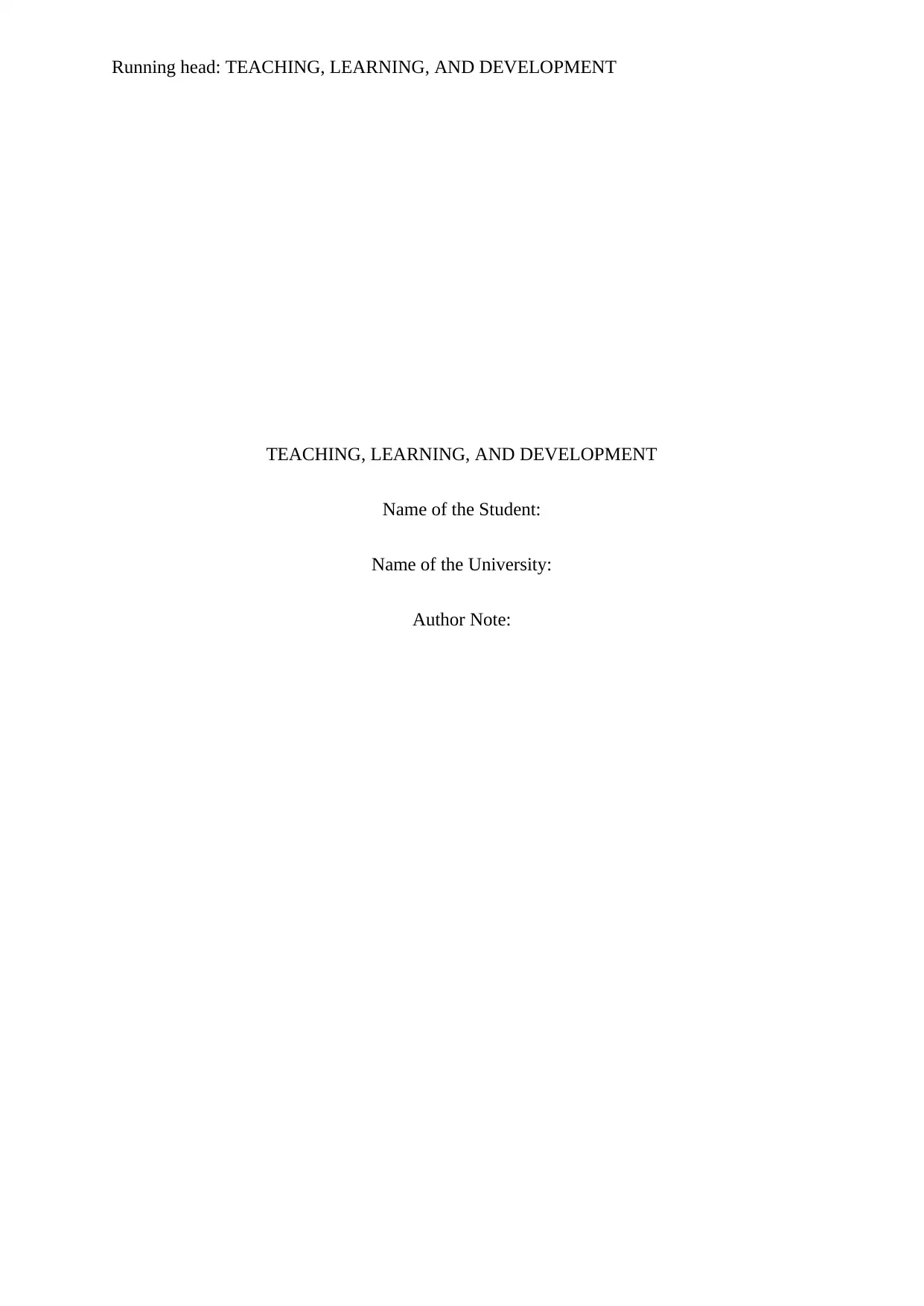
Running head: TEACHING, LEARNING, AND DEVELOPMENT
TEACHING, LEARNING, AND DEVELOPMENT
Name of the Student:
Name of the University:
Author Note:
TEACHING, LEARNING, AND DEVELOPMENT
Name of the Student:
Name of the University:
Author Note:
Paraphrase This Document
Need a fresh take? Get an instant paraphrase of this document with our AI Paraphraser
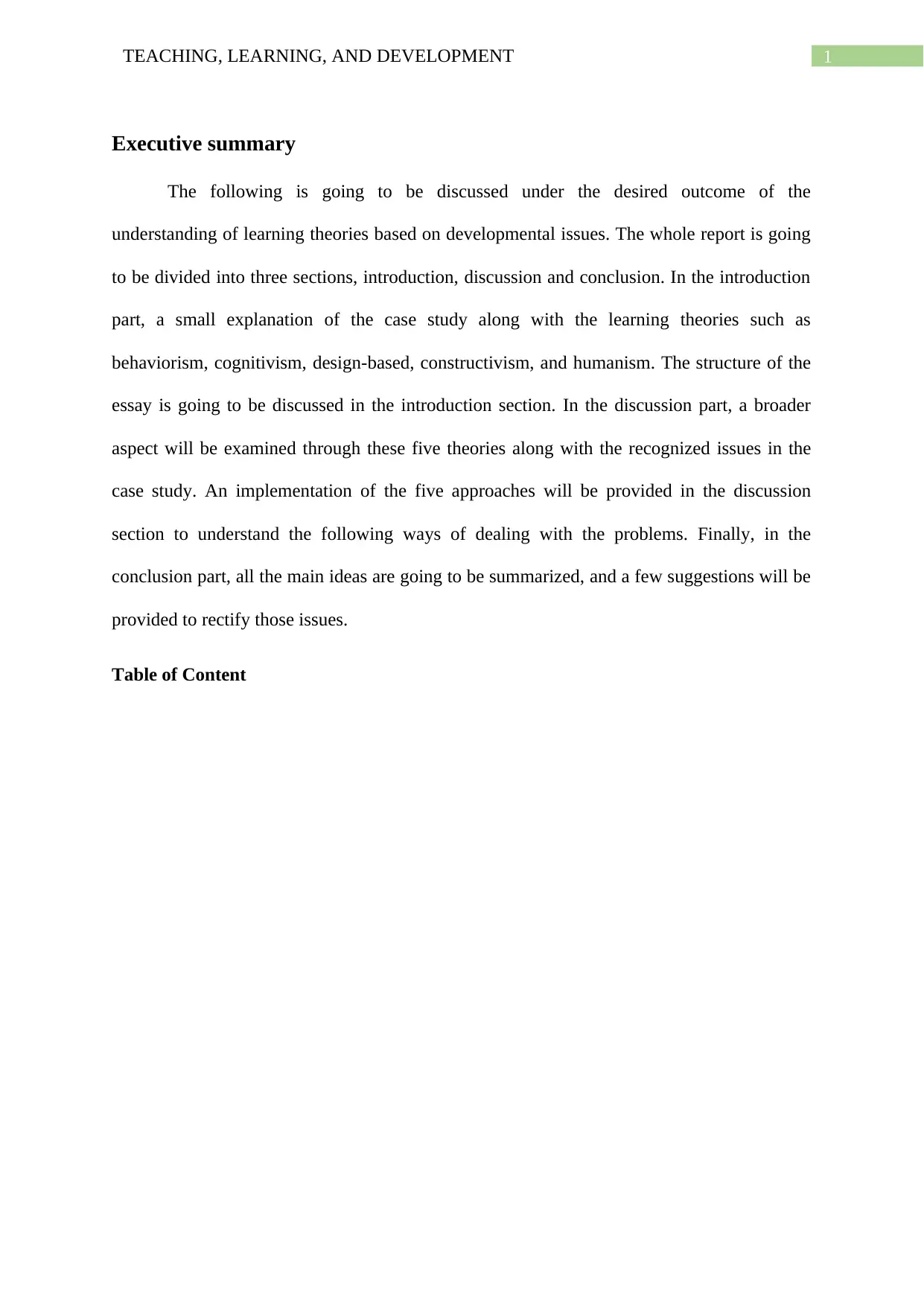
1TEACHING, LEARNING, AND DEVELOPMENT
Executive summary
The following is going to be discussed under the desired outcome of the
understanding of learning theories based on developmental issues. The whole report is going
to be divided into three sections, introduction, discussion and conclusion. In the introduction
part, a small explanation of the case study along with the learning theories such as
behaviorism, cognitivism, design-based, constructivism, and humanism. The structure of the
essay is going to be discussed in the introduction section. In the discussion part, a broader
aspect will be examined through these five theories along with the recognized issues in the
case study. An implementation of the five approaches will be provided in the discussion
section to understand the following ways of dealing with the problems. Finally, in the
conclusion part, all the main ideas are going to be summarized, and a few suggestions will be
provided to rectify those issues.
Table of Content
Executive summary
The following is going to be discussed under the desired outcome of the
understanding of learning theories based on developmental issues. The whole report is going
to be divided into three sections, introduction, discussion and conclusion. In the introduction
part, a small explanation of the case study along with the learning theories such as
behaviorism, cognitivism, design-based, constructivism, and humanism. The structure of the
essay is going to be discussed in the introduction section. In the discussion part, a broader
aspect will be examined through these five theories along with the recognized issues in the
case study. An implementation of the five approaches will be provided in the discussion
section to understand the following ways of dealing with the problems. Finally, in the
conclusion part, all the main ideas are going to be summarized, and a few suggestions will be
provided to rectify those issues.
Table of Content
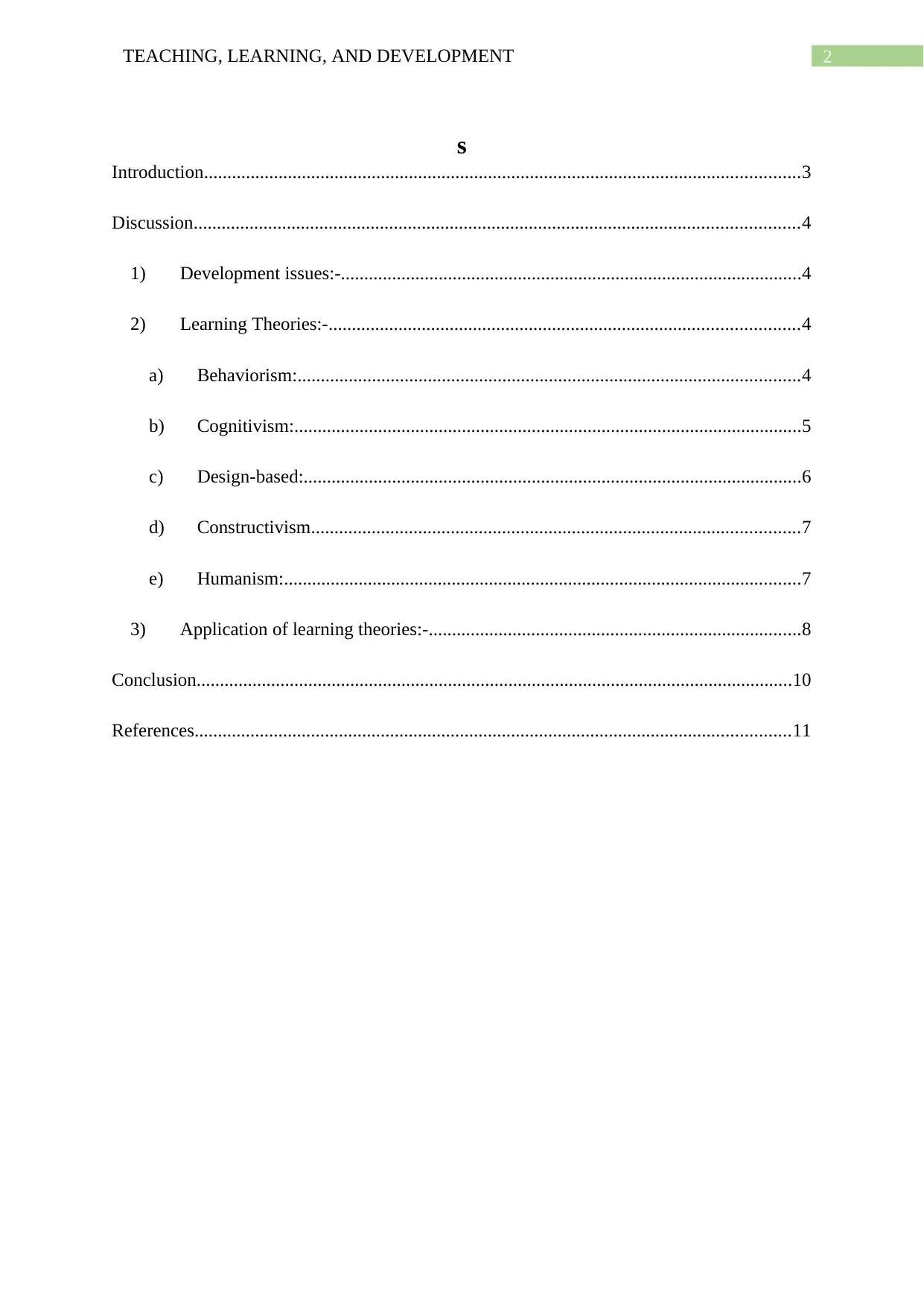
2TEACHING, LEARNING, AND DEVELOPMENT
s
Introduction................................................................................................................................3
Discussion..................................................................................................................................4
1) Development issues:-...................................................................................................4
2) Learning Theories:-.....................................................................................................4
a) Behaviorism:............................................................................................................4
b) Cognitivism:.............................................................................................................5
c) Design-based:...........................................................................................................6
d) Constructivism.........................................................................................................7
e) Humanism:...............................................................................................................7
3) Application of learning theories:-................................................................................8
Conclusion................................................................................................................................10
References................................................................................................................................11
s
Introduction................................................................................................................................3
Discussion..................................................................................................................................4
1) Development issues:-...................................................................................................4
2) Learning Theories:-.....................................................................................................4
a) Behaviorism:............................................................................................................4
b) Cognitivism:.............................................................................................................5
c) Design-based:...........................................................................................................6
d) Constructivism.........................................................................................................7
e) Humanism:...............................................................................................................7
3) Application of learning theories:-................................................................................8
Conclusion................................................................................................................................10
References................................................................................................................................11
⊘ This is a preview!⊘
Do you want full access?
Subscribe today to unlock all pages.

Trusted by 1+ million students worldwide
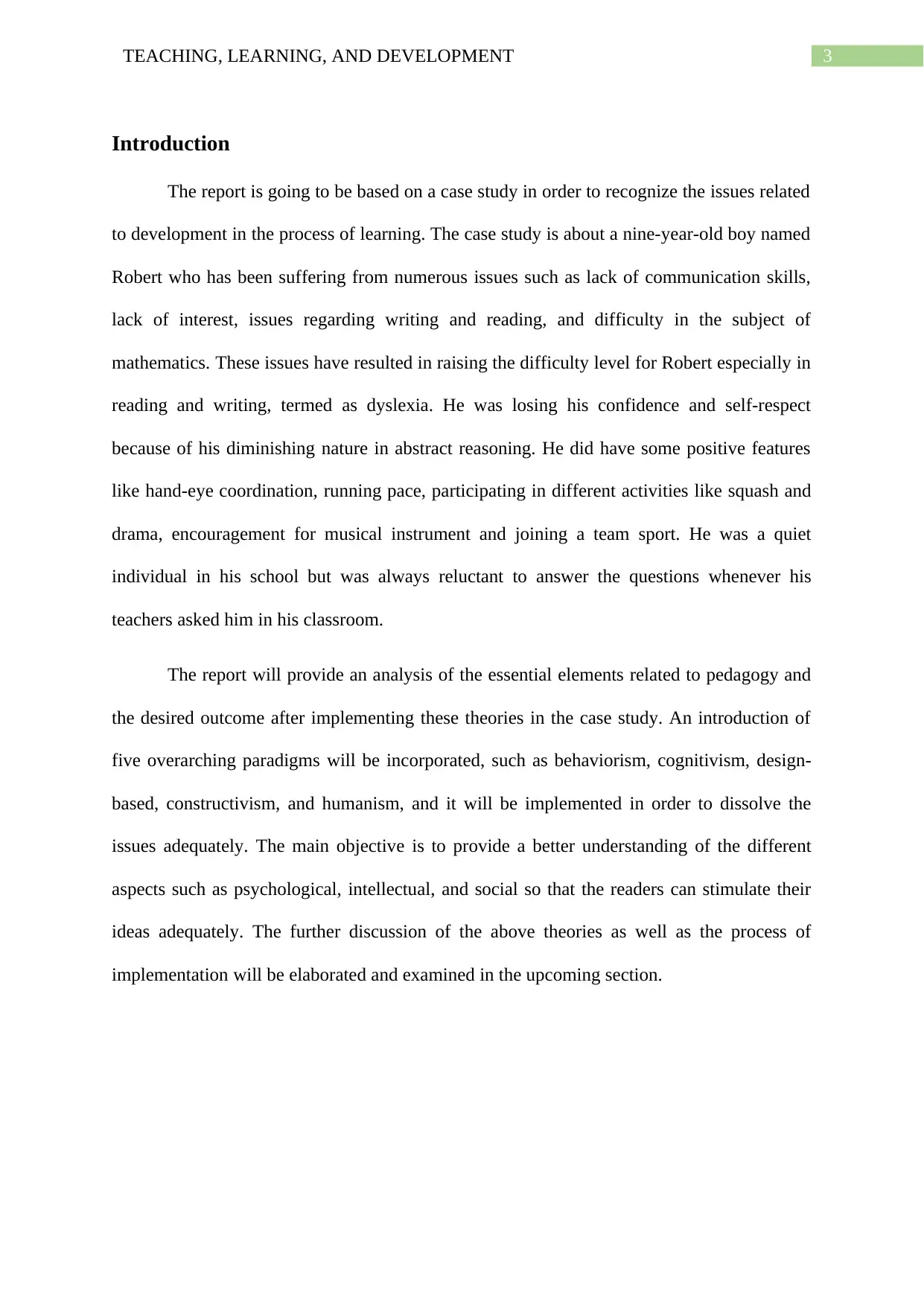
3TEACHING, LEARNING, AND DEVELOPMENT
Introduction
The report is going to be based on a case study in order to recognize the issues related
to development in the process of learning. The case study is about a nine-year-old boy named
Robert who has been suffering from numerous issues such as lack of communication skills,
lack of interest, issues regarding writing and reading, and difficulty in the subject of
mathematics. These issues have resulted in raising the difficulty level for Robert especially in
reading and writing, termed as dyslexia. He was losing his confidence and self-respect
because of his diminishing nature in abstract reasoning. He did have some positive features
like hand-eye coordination, running pace, participating in different activities like squash and
drama, encouragement for musical instrument and joining a team sport. He was a quiet
individual in his school but was always reluctant to answer the questions whenever his
teachers asked him in his classroom.
The report will provide an analysis of the essential elements related to pedagogy and
the desired outcome after implementing these theories in the case study. An introduction of
five overarching paradigms will be incorporated, such as behaviorism, cognitivism, design-
based, constructivism, and humanism, and it will be implemented in order to dissolve the
issues adequately. The main objective is to provide a better understanding of the different
aspects such as psychological, intellectual, and social so that the readers can stimulate their
ideas adequately. The further discussion of the above theories as well as the process of
implementation will be elaborated and examined in the upcoming section.
Introduction
The report is going to be based on a case study in order to recognize the issues related
to development in the process of learning. The case study is about a nine-year-old boy named
Robert who has been suffering from numerous issues such as lack of communication skills,
lack of interest, issues regarding writing and reading, and difficulty in the subject of
mathematics. These issues have resulted in raising the difficulty level for Robert especially in
reading and writing, termed as dyslexia. He was losing his confidence and self-respect
because of his diminishing nature in abstract reasoning. He did have some positive features
like hand-eye coordination, running pace, participating in different activities like squash and
drama, encouragement for musical instrument and joining a team sport. He was a quiet
individual in his school but was always reluctant to answer the questions whenever his
teachers asked him in his classroom.
The report will provide an analysis of the essential elements related to pedagogy and
the desired outcome after implementing these theories in the case study. An introduction of
five overarching paradigms will be incorporated, such as behaviorism, cognitivism, design-
based, constructivism, and humanism, and it will be implemented in order to dissolve the
issues adequately. The main objective is to provide a better understanding of the different
aspects such as psychological, intellectual, and social so that the readers can stimulate their
ideas adequately. The further discussion of the above theories as well as the process of
implementation will be elaborated and examined in the upcoming section.
Paraphrase This Document
Need a fresh take? Get an instant paraphrase of this document with our AI Paraphraser
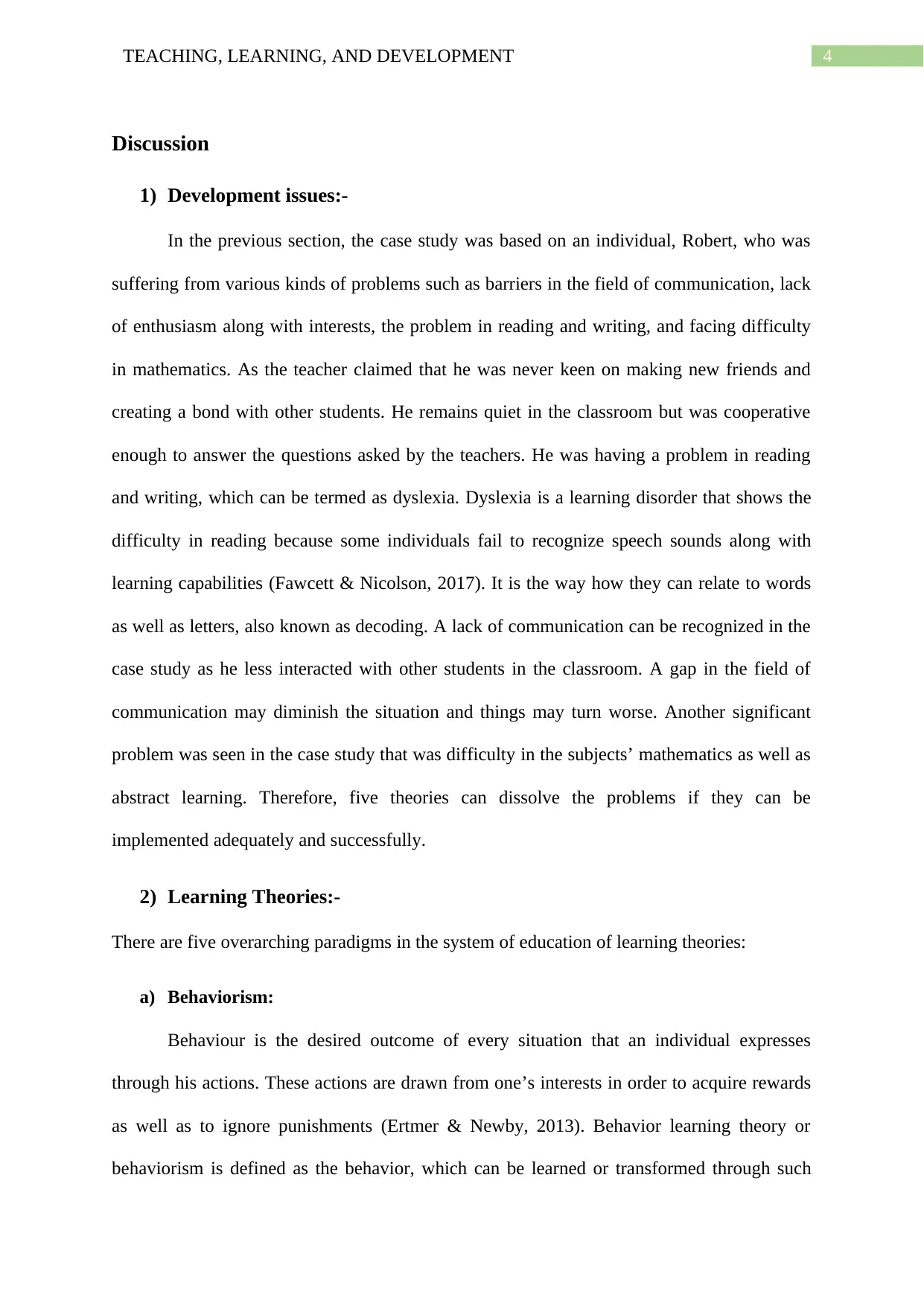
4TEACHING, LEARNING, AND DEVELOPMENT
Discussion
1) Development issues:-
In the previous section, the case study was based on an individual, Robert, who was
suffering from various kinds of problems such as barriers in the field of communication, lack
of enthusiasm along with interests, the problem in reading and writing, and facing difficulty
in mathematics. As the teacher claimed that he was never keen on making new friends and
creating a bond with other students. He remains quiet in the classroom but was cooperative
enough to answer the questions asked by the teachers. He was having a problem in reading
and writing, which can be termed as dyslexia. Dyslexia is a learning disorder that shows the
difficulty in reading because some individuals fail to recognize speech sounds along with
learning capabilities (Fawcett & Nicolson, 2017). It is the way how they can relate to words
as well as letters, also known as decoding. A lack of communication can be recognized in the
case study as he less interacted with other students in the classroom. A gap in the field of
communication may diminish the situation and things may turn worse. Another significant
problem was seen in the case study that was difficulty in the subjects’ mathematics as well as
abstract learning. Therefore, five theories can dissolve the problems if they can be
implemented adequately and successfully.
2) Learning Theories:-
There are five overarching paradigms in the system of education of learning theories:
a) Behaviorism:
Behaviour is the desired outcome of every situation that an individual expresses
through his actions. These actions are drawn from one’s interests in order to acquire rewards
as well as to ignore punishments (Ertmer & Newby, 2013). Behavior learning theory or
behaviorism is defined as the behavior, which can be learned or transformed through such
Discussion
1) Development issues:-
In the previous section, the case study was based on an individual, Robert, who was
suffering from various kinds of problems such as barriers in the field of communication, lack
of enthusiasm along with interests, the problem in reading and writing, and facing difficulty
in mathematics. As the teacher claimed that he was never keen on making new friends and
creating a bond with other students. He remains quiet in the classroom but was cooperative
enough to answer the questions asked by the teachers. He was having a problem in reading
and writing, which can be termed as dyslexia. Dyslexia is a learning disorder that shows the
difficulty in reading because some individuals fail to recognize speech sounds along with
learning capabilities (Fawcett & Nicolson, 2017). It is the way how they can relate to words
as well as letters, also known as decoding. A lack of communication can be recognized in the
case study as he less interacted with other students in the classroom. A gap in the field of
communication may diminish the situation and things may turn worse. Another significant
problem was seen in the case study that was difficulty in the subjects’ mathematics as well as
abstract learning. Therefore, five theories can dissolve the problems if they can be
implemented adequately and successfully.
2) Learning Theories:-
There are five overarching paradigms in the system of education of learning theories:
a) Behaviorism:
Behaviour is the desired outcome of every situation that an individual expresses
through his actions. These actions are drawn from one’s interests in order to acquire rewards
as well as to ignore punishments (Ertmer & Newby, 2013). Behavior learning theory or
behaviorism is defined as the behavior, which can be learned or transformed through such
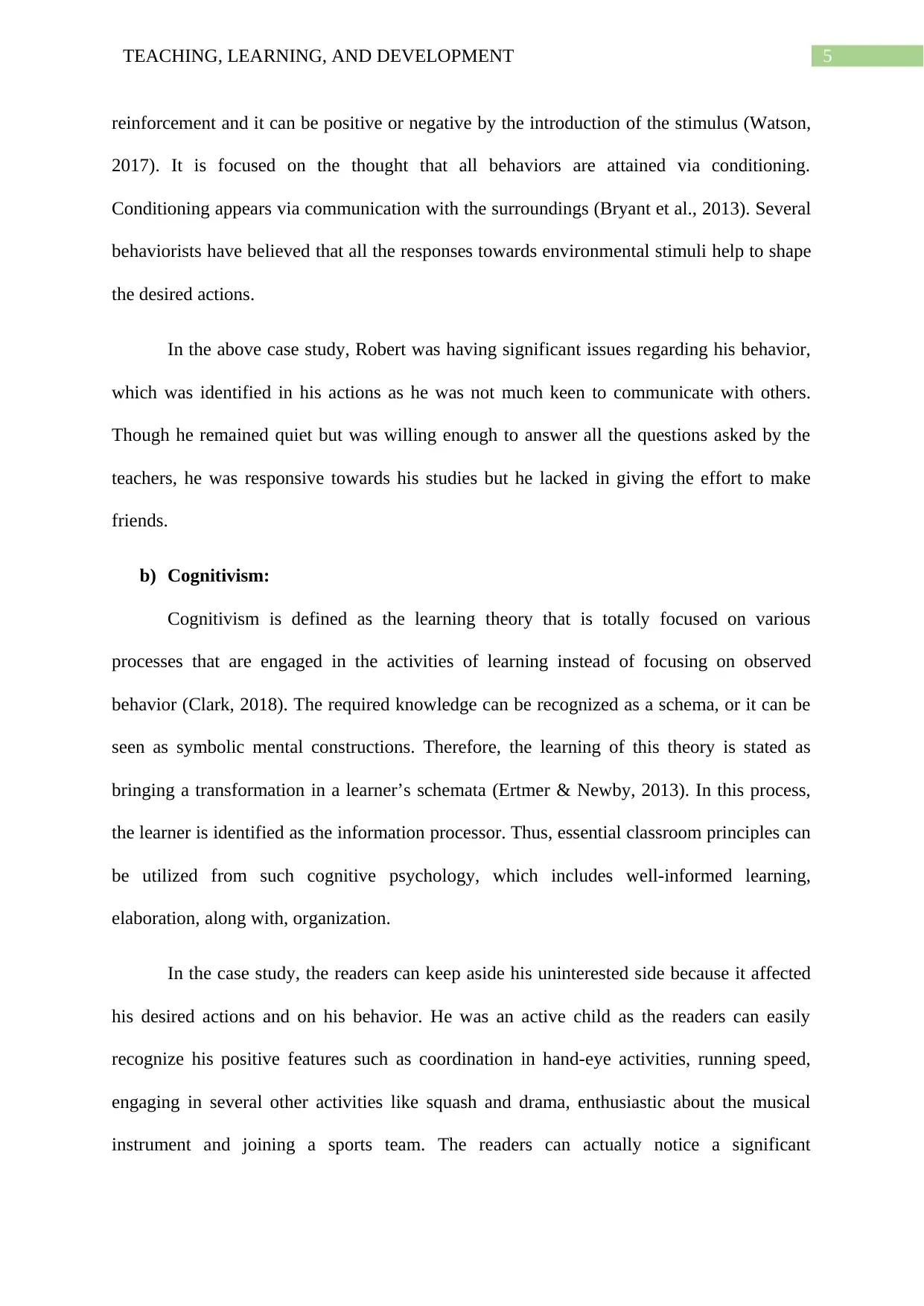
5TEACHING, LEARNING, AND DEVELOPMENT
reinforcement and it can be positive or negative by the introduction of the stimulus (Watson,
2017). It is focused on the thought that all behaviors are attained via conditioning.
Conditioning appears via communication with the surroundings (Bryant et al., 2013). Several
behaviorists have believed that all the responses towards environmental stimuli help to shape
the desired actions.
In the above case study, Robert was having significant issues regarding his behavior,
which was identified in his actions as he was not much keen to communicate with others.
Though he remained quiet but was willing enough to answer all the questions asked by the
teachers, he was responsive towards his studies but he lacked in giving the effort to make
friends.
b) Cognitivism:
Cognitivism is defined as the learning theory that is totally focused on various
processes that are engaged in the activities of learning instead of focusing on observed
behavior (Clark, 2018). The required knowledge can be recognized as a schema, or it can be
seen as symbolic mental constructions. Therefore, the learning of this theory is stated as
bringing a transformation in a learner’s schemata (Ertmer & Newby, 2013). In this process,
the learner is identified as the information processor. Thus, essential classroom principles can
be utilized from such cognitive psychology, which includes well-informed learning,
elaboration, along with, organization.
In the case study, the readers can keep aside his uninterested side because it affected
his desired actions and on his behavior. He was an active child as the readers can easily
recognize his positive features such as coordination in hand-eye activities, running speed,
engaging in several other activities like squash and drama, enthusiastic about the musical
instrument and joining a sports team. The readers can actually notice a significant
reinforcement and it can be positive or negative by the introduction of the stimulus (Watson,
2017). It is focused on the thought that all behaviors are attained via conditioning.
Conditioning appears via communication with the surroundings (Bryant et al., 2013). Several
behaviorists have believed that all the responses towards environmental stimuli help to shape
the desired actions.
In the above case study, Robert was having significant issues regarding his behavior,
which was identified in his actions as he was not much keen to communicate with others.
Though he remained quiet but was willing enough to answer all the questions asked by the
teachers, he was responsive towards his studies but he lacked in giving the effort to make
friends.
b) Cognitivism:
Cognitivism is defined as the learning theory that is totally focused on various
processes that are engaged in the activities of learning instead of focusing on observed
behavior (Clark, 2018). The required knowledge can be recognized as a schema, or it can be
seen as symbolic mental constructions. Therefore, the learning of this theory is stated as
bringing a transformation in a learner’s schemata (Ertmer & Newby, 2013). In this process,
the learner is identified as the information processor. Thus, essential classroom principles can
be utilized from such cognitive psychology, which includes well-informed learning,
elaboration, along with, organization.
In the case study, the readers can keep aside his uninterested side because it affected
his desired actions and on his behavior. He was an active child as the readers can easily
recognize his positive features such as coordination in hand-eye activities, running speed,
engaging in several other activities like squash and drama, enthusiastic about the musical
instrument and joining a sports team. The readers can actually notice a significant
⊘ This is a preview!⊘
Do you want full access?
Subscribe today to unlock all pages.

Trusted by 1+ million students worldwide
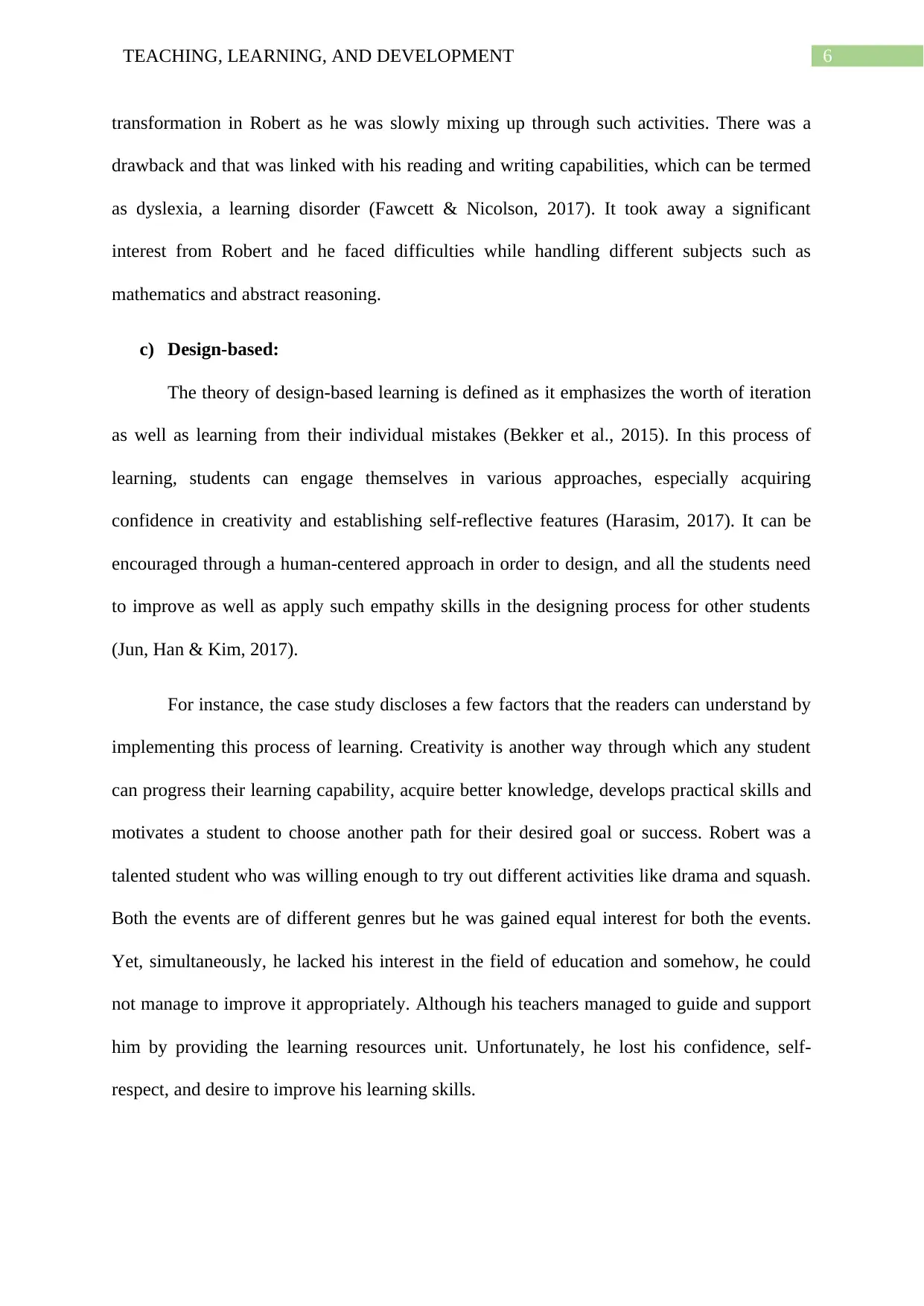
6TEACHING, LEARNING, AND DEVELOPMENT
transformation in Robert as he was slowly mixing up through such activities. There was a
drawback and that was linked with his reading and writing capabilities, which can be termed
as dyslexia, a learning disorder (Fawcett & Nicolson, 2017). It took away a significant
interest from Robert and he faced difficulties while handling different subjects such as
mathematics and abstract reasoning.
c) Design-based:
The theory of design-based learning is defined as it emphasizes the worth of iteration
as well as learning from their individual mistakes (Bekker et al., 2015). In this process of
learning, students can engage themselves in various approaches, especially acquiring
confidence in creativity and establishing self-reflective features (Harasim, 2017). It can be
encouraged through a human-centered approach in order to design, and all the students need
to improve as well as apply such empathy skills in the designing process for other students
(Jun, Han & Kim, 2017).
For instance, the case study discloses a few factors that the readers can understand by
implementing this process of learning. Creativity is another way through which any student
can progress their learning capability, acquire better knowledge, develops practical skills and
motivates a student to choose another path for their desired goal or success. Robert was a
talented student who was willing enough to try out different activities like drama and squash.
Both the events are of different genres but he was gained equal interest for both the events.
Yet, simultaneously, he lacked his interest in the field of education and somehow, he could
not manage to improve it appropriately. Although his teachers managed to guide and support
him by providing the learning resources unit. Unfortunately, he lost his confidence, self-
respect, and desire to improve his learning skills.
transformation in Robert as he was slowly mixing up through such activities. There was a
drawback and that was linked with his reading and writing capabilities, which can be termed
as dyslexia, a learning disorder (Fawcett & Nicolson, 2017). It took away a significant
interest from Robert and he faced difficulties while handling different subjects such as
mathematics and abstract reasoning.
c) Design-based:
The theory of design-based learning is defined as it emphasizes the worth of iteration
as well as learning from their individual mistakes (Bekker et al., 2015). In this process of
learning, students can engage themselves in various approaches, especially acquiring
confidence in creativity and establishing self-reflective features (Harasim, 2017). It can be
encouraged through a human-centered approach in order to design, and all the students need
to improve as well as apply such empathy skills in the designing process for other students
(Jun, Han & Kim, 2017).
For instance, the case study discloses a few factors that the readers can understand by
implementing this process of learning. Creativity is another way through which any student
can progress their learning capability, acquire better knowledge, develops practical skills and
motivates a student to choose another path for their desired goal or success. Robert was a
talented student who was willing enough to try out different activities like drama and squash.
Both the events are of different genres but he was gained equal interest for both the events.
Yet, simultaneously, he lacked his interest in the field of education and somehow, he could
not manage to improve it appropriately. Although his teachers managed to guide and support
him by providing the learning resources unit. Unfortunately, he lost his confidence, self-
respect, and desire to improve his learning skills.
Paraphrase This Document
Need a fresh take? Get an instant paraphrase of this document with our AI Paraphraser
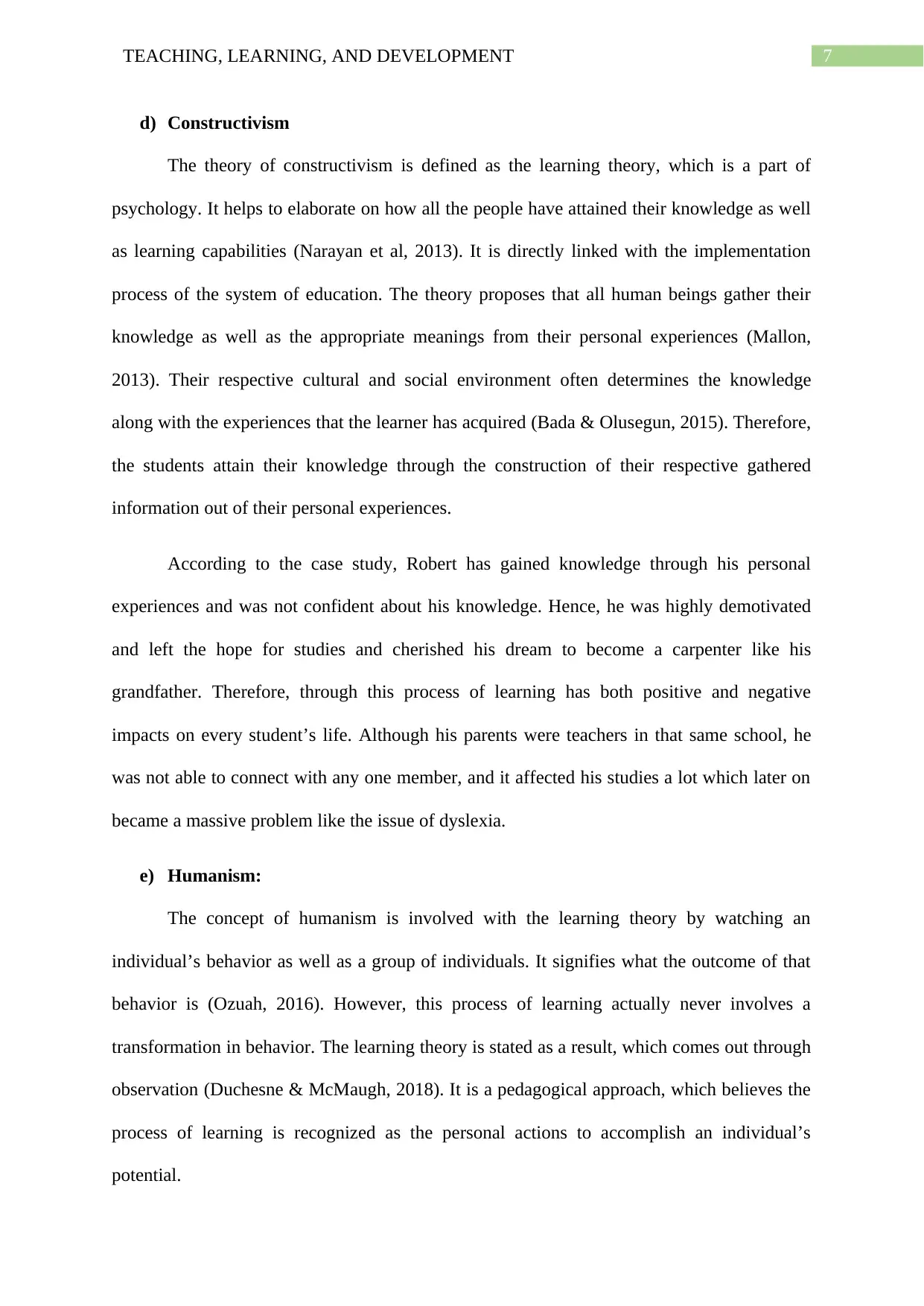
7TEACHING, LEARNING, AND DEVELOPMENT
d) Constructivism
The theory of constructivism is defined as the learning theory, which is a part of
psychology. It helps to elaborate on how all the people have attained their knowledge as well
as learning capabilities (Narayan et al, 2013). It is directly linked with the implementation
process of the system of education. The theory proposes that all human beings gather their
knowledge as well as the appropriate meanings from their personal experiences (Mallon,
2013). Their respective cultural and social environment often determines the knowledge
along with the experiences that the learner has acquired (Bada & Olusegun, 2015). Therefore,
the students attain their knowledge through the construction of their respective gathered
information out of their personal experiences.
According to the case study, Robert has gained knowledge through his personal
experiences and was not confident about his knowledge. Hence, he was highly demotivated
and left the hope for studies and cherished his dream to become a carpenter like his
grandfather. Therefore, through this process of learning has both positive and negative
impacts on every student’s life. Although his parents were teachers in that same school, he
was not able to connect with any one member, and it affected his studies a lot which later on
became a massive problem like the issue of dyslexia.
e) Humanism:
The concept of humanism is involved with the learning theory by watching an
individual’s behavior as well as a group of individuals. It signifies what the outcome of that
behavior is (Ozuah, 2016). However, this process of learning actually never involves a
transformation in behavior. The learning theory is stated as a result, which comes out through
observation (Duchesne & McMaugh, 2018). It is a pedagogical approach, which believes the
process of learning is recognized as the personal actions to accomplish an individual’s
potential.
d) Constructivism
The theory of constructivism is defined as the learning theory, which is a part of
psychology. It helps to elaborate on how all the people have attained their knowledge as well
as learning capabilities (Narayan et al, 2013). It is directly linked with the implementation
process of the system of education. The theory proposes that all human beings gather their
knowledge as well as the appropriate meanings from their personal experiences (Mallon,
2013). Their respective cultural and social environment often determines the knowledge
along with the experiences that the learner has acquired (Bada & Olusegun, 2015). Therefore,
the students attain their knowledge through the construction of their respective gathered
information out of their personal experiences.
According to the case study, Robert has gained knowledge through his personal
experiences and was not confident about his knowledge. Hence, he was highly demotivated
and left the hope for studies and cherished his dream to become a carpenter like his
grandfather. Therefore, through this process of learning has both positive and negative
impacts on every student’s life. Although his parents were teachers in that same school, he
was not able to connect with any one member, and it affected his studies a lot which later on
became a massive problem like the issue of dyslexia.
e) Humanism:
The concept of humanism is involved with the learning theory by watching an
individual’s behavior as well as a group of individuals. It signifies what the outcome of that
behavior is (Ozuah, 2016). However, this process of learning actually never involves a
transformation in behavior. The learning theory is stated as a result, which comes out through
observation (Duchesne & McMaugh, 2018). It is a pedagogical approach, which believes the
process of learning is recognized as the personal actions to accomplish an individual’s
potential.
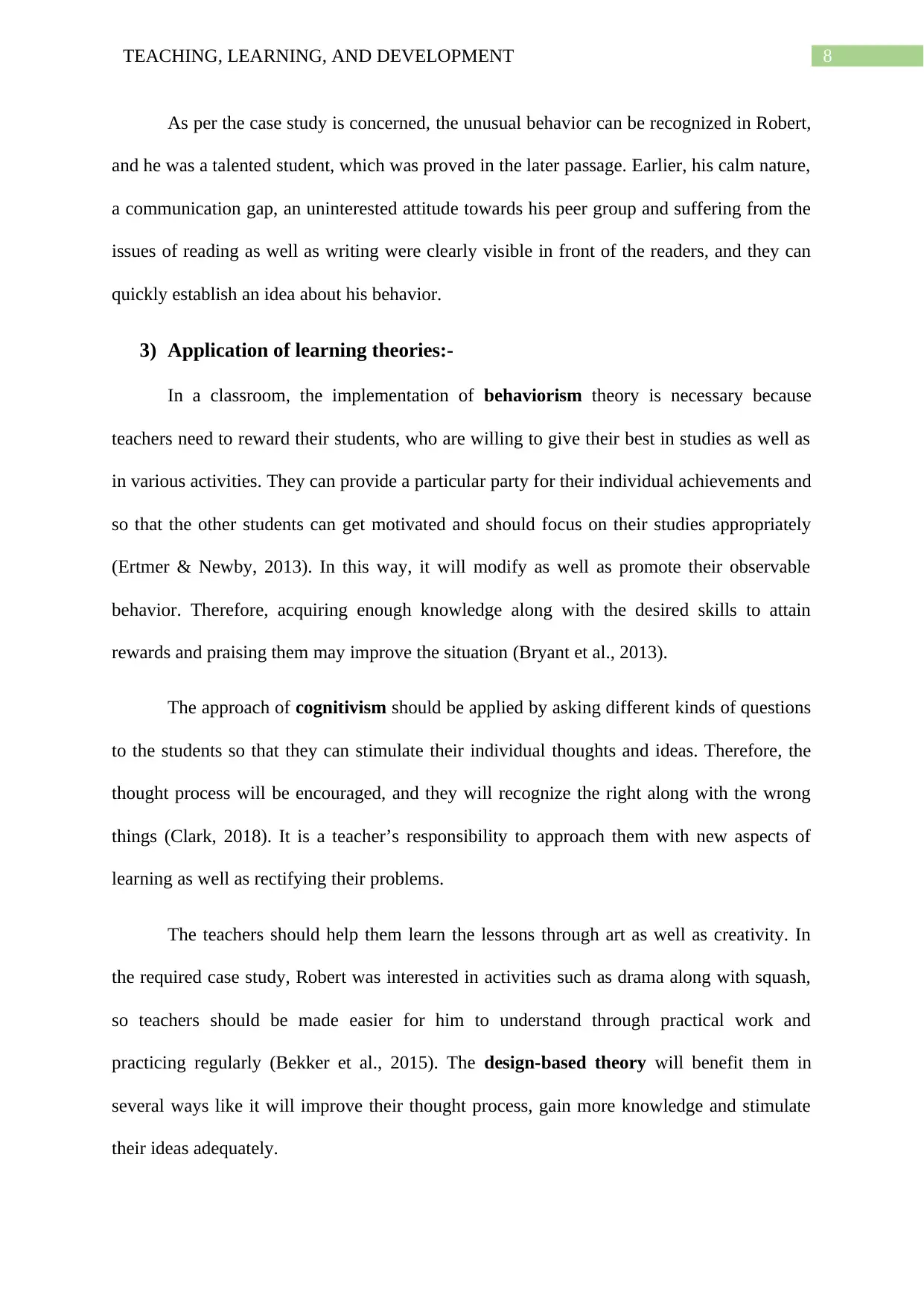
8TEACHING, LEARNING, AND DEVELOPMENT
As per the case study is concerned, the unusual behavior can be recognized in Robert,
and he was a talented student, which was proved in the later passage. Earlier, his calm nature,
a communication gap, an uninterested attitude towards his peer group and suffering from the
issues of reading as well as writing were clearly visible in front of the readers, and they can
quickly establish an idea about his behavior.
3) Application of learning theories:-
In a classroom, the implementation of behaviorism theory is necessary because
teachers need to reward their students, who are willing to give their best in studies as well as
in various activities. They can provide a particular party for their individual achievements and
so that the other students can get motivated and should focus on their studies appropriately
(Ertmer & Newby, 2013). In this way, it will modify as well as promote their observable
behavior. Therefore, acquiring enough knowledge along with the desired skills to attain
rewards and praising them may improve the situation (Bryant et al., 2013).
The approach of cognitivism should be applied by asking different kinds of questions
to the students so that they can stimulate their individual thoughts and ideas. Therefore, the
thought process will be encouraged, and they will recognize the right along with the wrong
things (Clark, 2018). It is a teacher’s responsibility to approach them with new aspects of
learning as well as rectifying their problems.
The teachers should help them learn the lessons through art as well as creativity. In
the required case study, Robert was interested in activities such as drama along with squash,
so teachers should be made easier for him to understand through practical work and
practicing regularly (Bekker et al., 2015). The design-based theory will benefit them in
several ways like it will improve their thought process, gain more knowledge and stimulate
their ideas adequately.
As per the case study is concerned, the unusual behavior can be recognized in Robert,
and he was a talented student, which was proved in the later passage. Earlier, his calm nature,
a communication gap, an uninterested attitude towards his peer group and suffering from the
issues of reading as well as writing were clearly visible in front of the readers, and they can
quickly establish an idea about his behavior.
3) Application of learning theories:-
In a classroom, the implementation of behaviorism theory is necessary because
teachers need to reward their students, who are willing to give their best in studies as well as
in various activities. They can provide a particular party for their individual achievements and
so that the other students can get motivated and should focus on their studies appropriately
(Ertmer & Newby, 2013). In this way, it will modify as well as promote their observable
behavior. Therefore, acquiring enough knowledge along with the desired skills to attain
rewards and praising them may improve the situation (Bryant et al., 2013).
The approach of cognitivism should be applied by asking different kinds of questions
to the students so that they can stimulate their individual thoughts and ideas. Therefore, the
thought process will be encouraged, and they will recognize the right along with the wrong
things (Clark, 2018). It is a teacher’s responsibility to approach them with new aspects of
learning as well as rectifying their problems.
The teachers should help them learn the lessons through art as well as creativity. In
the required case study, Robert was interested in activities such as drama along with squash,
so teachers should be made easier for him to understand through practical work and
practicing regularly (Bekker et al., 2015). The design-based theory will benefit them in
several ways like it will improve their thought process, gain more knowledge and stimulate
their ideas adequately.
⊘ This is a preview!⊘
Do you want full access?
Subscribe today to unlock all pages.

Trusted by 1+ million students worldwide
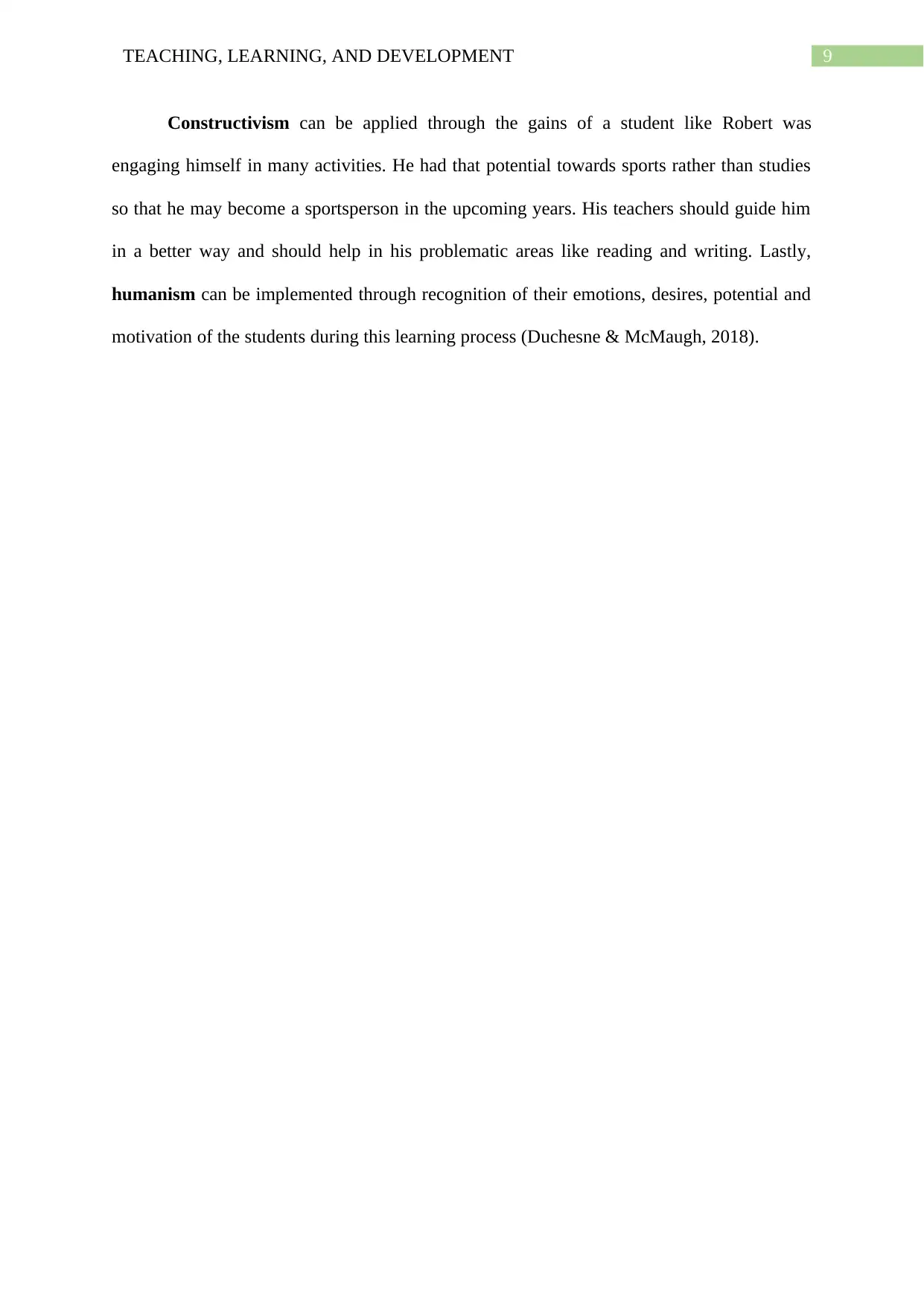
9TEACHING, LEARNING, AND DEVELOPMENT
Constructivism can be applied through the gains of a student like Robert was
engaging himself in many activities. He had that potential towards sports rather than studies
so that he may become a sportsperson in the upcoming years. His teachers should guide him
in a better way and should help in his problematic areas like reading and writing. Lastly,
humanism can be implemented through recognition of their emotions, desires, potential and
motivation of the students during this learning process (Duchesne & McMaugh, 2018).
Constructivism can be applied through the gains of a student like Robert was
engaging himself in many activities. He had that potential towards sports rather than studies
so that he may become a sportsperson in the upcoming years. His teachers should guide him
in a better way and should help in his problematic areas like reading and writing. Lastly,
humanism can be implemented through recognition of their emotions, desires, potential and
motivation of the students during this learning process (Duchesne & McMaugh, 2018).
Paraphrase This Document
Need a fresh take? Get an instant paraphrase of this document with our AI Paraphraser
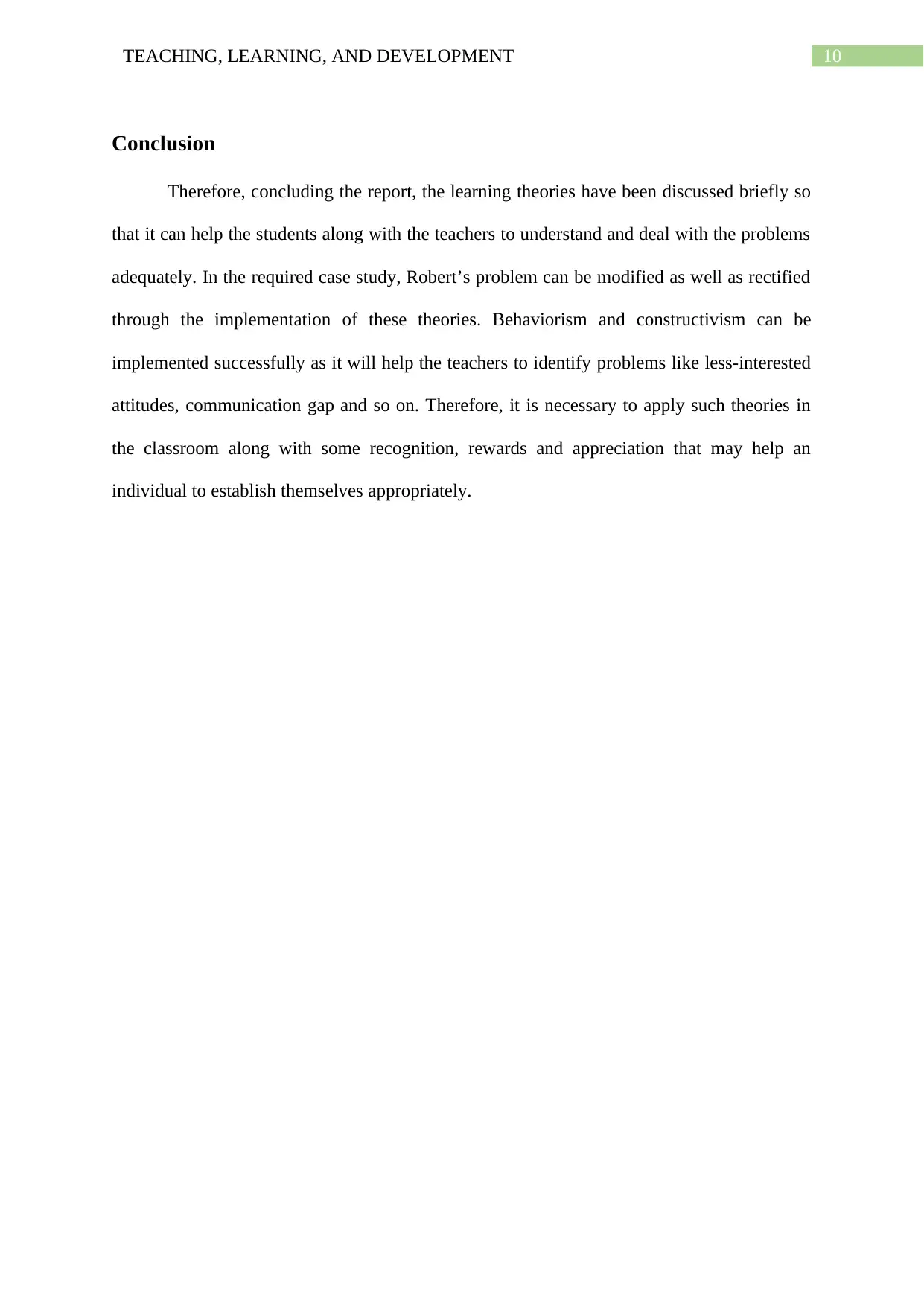
10TEACHING, LEARNING, AND DEVELOPMENT
Conclusion
Therefore, concluding the report, the learning theories have been discussed briefly so
that it can help the students along with the teachers to understand and deal with the problems
adequately. In the required case study, Robert’s problem can be modified as well as rectified
through the implementation of these theories. Behaviorism and constructivism can be
implemented successfully as it will help the teachers to identify problems like less-interested
attitudes, communication gap and so on. Therefore, it is necessary to apply such theories in
the classroom along with some recognition, rewards and appreciation that may help an
individual to establish themselves appropriately.
Conclusion
Therefore, concluding the report, the learning theories have been discussed briefly so
that it can help the students along with the teachers to understand and deal with the problems
adequately. In the required case study, Robert’s problem can be modified as well as rectified
through the implementation of these theories. Behaviorism and constructivism can be
implemented successfully as it will help the teachers to identify problems like less-interested
attitudes, communication gap and so on. Therefore, it is necessary to apply such theories in
the classroom along with some recognition, rewards and appreciation that may help an
individual to establish themselves appropriately.
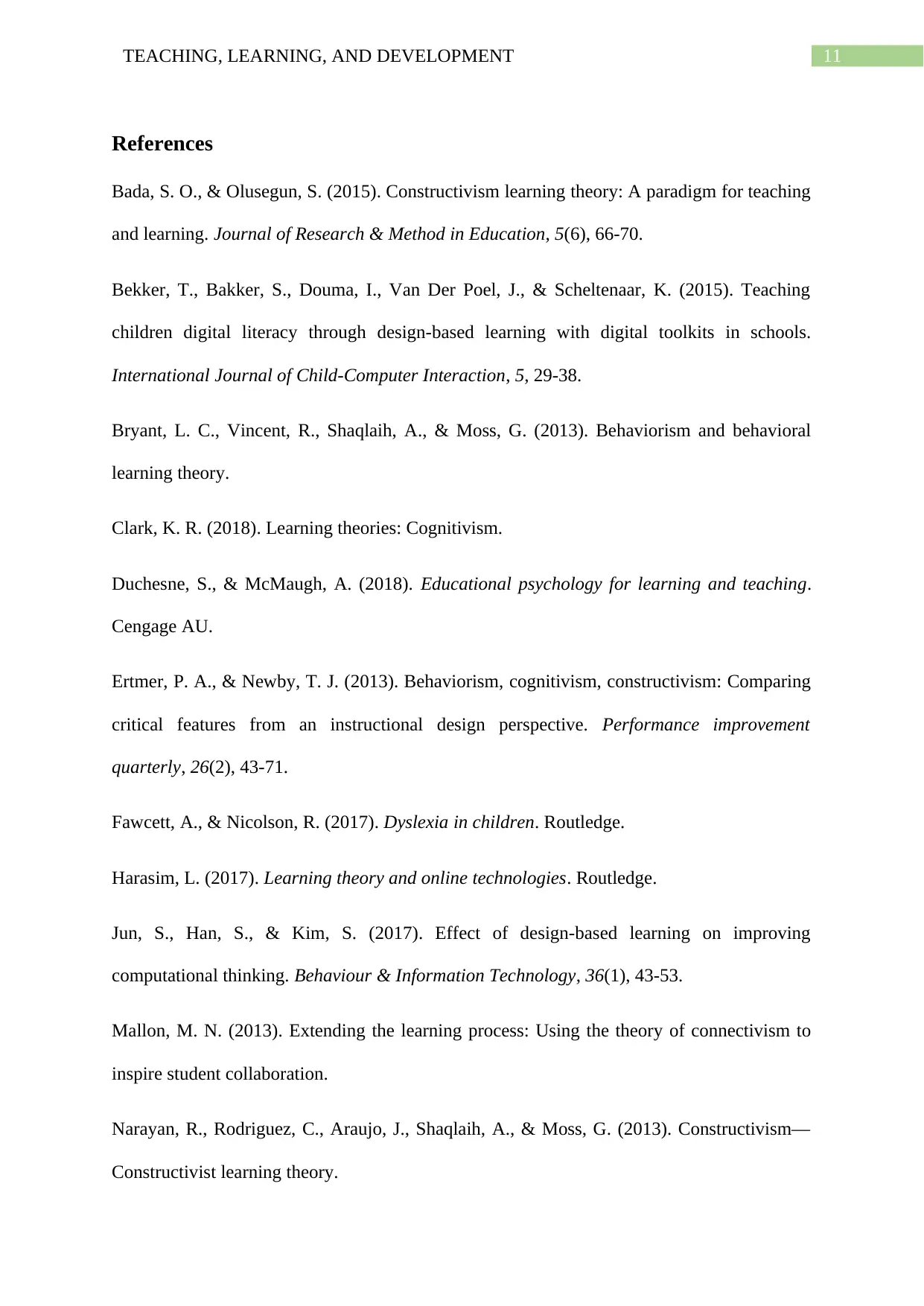
11TEACHING, LEARNING, AND DEVELOPMENT
References
Bada, S. O., & Olusegun, S. (2015). Constructivism learning theory: A paradigm for teaching
and learning. Journal of Research & Method in Education, 5(6), 66-70.
Bekker, T., Bakker, S., Douma, I., Van Der Poel, J., & Scheltenaar, K. (2015). Teaching
children digital literacy through design-based learning with digital toolkits in schools.
International Journal of Child-Computer Interaction, 5, 29-38.
Bryant, L. C., Vincent, R., Shaqlaih, A., & Moss, G. (2013). Behaviorism and behavioral
learning theory.
Clark, K. R. (2018). Learning theories: Cognitivism.
Duchesne, S., & McMaugh, A. (2018). Educational psychology for learning and teaching.
Cengage AU.
Ertmer, P. A., & Newby, T. J. (2013). Behaviorism, cognitivism, constructivism: Comparing
critical features from an instructional design perspective. Performance improvement
quarterly, 26(2), 43-71.
Fawcett, A., & Nicolson, R. (2017). Dyslexia in children. Routledge.
Harasim, L. (2017). Learning theory and online technologies. Routledge.
Jun, S., Han, S., & Kim, S. (2017). Effect of design-based learning on improving
computational thinking. Behaviour & Information Technology, 36(1), 43-53.
Mallon, M. N. (2013). Extending the learning process: Using the theory of connectivism to
inspire student collaboration.
Narayan, R., Rodriguez, C., Araujo, J., Shaqlaih, A., & Moss, G. (2013). Constructivism—
Constructivist learning theory.
References
Bada, S. O., & Olusegun, S. (2015). Constructivism learning theory: A paradigm for teaching
and learning. Journal of Research & Method in Education, 5(6), 66-70.
Bekker, T., Bakker, S., Douma, I., Van Der Poel, J., & Scheltenaar, K. (2015). Teaching
children digital literacy through design-based learning with digital toolkits in schools.
International Journal of Child-Computer Interaction, 5, 29-38.
Bryant, L. C., Vincent, R., Shaqlaih, A., & Moss, G. (2013). Behaviorism and behavioral
learning theory.
Clark, K. R. (2018). Learning theories: Cognitivism.
Duchesne, S., & McMaugh, A. (2018). Educational psychology for learning and teaching.
Cengage AU.
Ertmer, P. A., & Newby, T. J. (2013). Behaviorism, cognitivism, constructivism: Comparing
critical features from an instructional design perspective. Performance improvement
quarterly, 26(2), 43-71.
Fawcett, A., & Nicolson, R. (2017). Dyslexia in children. Routledge.
Harasim, L. (2017). Learning theory and online technologies. Routledge.
Jun, S., Han, S., & Kim, S. (2017). Effect of design-based learning on improving
computational thinking. Behaviour & Information Technology, 36(1), 43-53.
Mallon, M. N. (2013). Extending the learning process: Using the theory of connectivism to
inspire student collaboration.
Narayan, R., Rodriguez, C., Araujo, J., Shaqlaih, A., & Moss, G. (2013). Constructivism—
Constructivist learning theory.
⊘ This is a preview!⊘
Do you want full access?
Subscribe today to unlock all pages.

Trusted by 1+ million students worldwide
1 out of 13
Related Documents
Your All-in-One AI-Powered Toolkit for Academic Success.
+13062052269
info@desklib.com
Available 24*7 on WhatsApp / Email
![[object Object]](/_next/static/media/star-bottom.7253800d.svg)
Unlock your academic potential
Copyright © 2020–2025 A2Z Services. All Rights Reserved. Developed and managed by ZUCOL.




